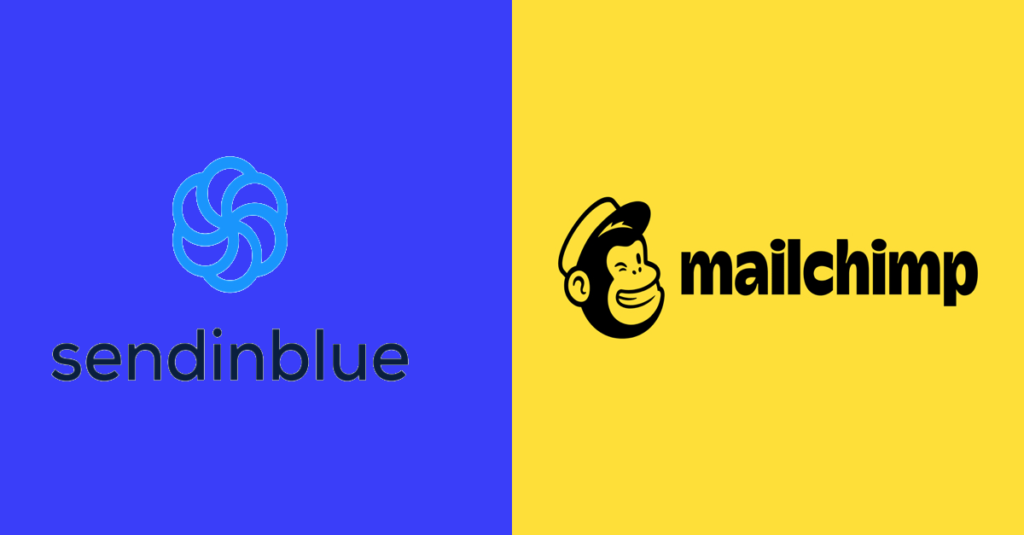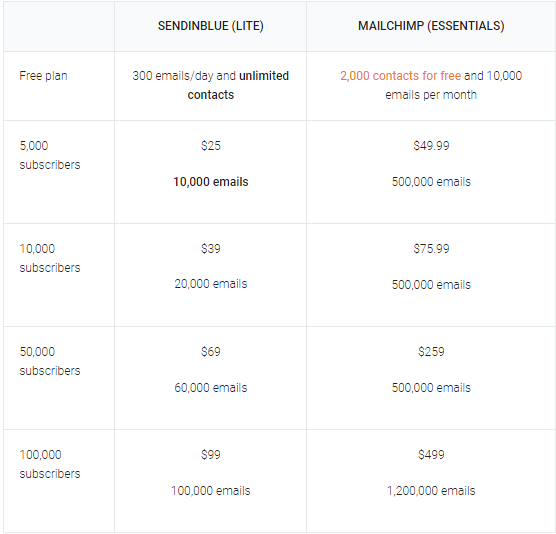
Mailchimp nowadays is providing its services to more than 20millions clients around the globe, and you wouldn’t know the main reason behind that, is it the quality services? Or is it good marketing? What is actually attracting customers to get engaged in such platforms?
Mailchimp now is charging users according to their contacts, and while everyone is asking the ultimate question “Is there a free alternative to Mailchimp?” maybe a different company was paving the way for itself to rise.
SendInBlue, a French company owned by Armand Thiberge that is day by day growing all around the world and now is providing its services to more than 80,000 clients.
Mailchimp and SendInBlue, both platforms offer so many features to their users, However, they differ in so many points, and that’s what distinguishes each platform, and to answer probably your question, “is Mailchimp still the best?”
So, either you are new to email marketing or you are doing your researches trying to find what’s the best deal for your business or you are interested in learning more about the new adversary of Mailchimp, this article is for you, we will compare the two platforms so you can have a clearer idea about them.
- List Management :
Mailchimp doesn’t provide a great experience to its users concerning this feature. In other words, in Mailchimp, you can’t put contacts on different lists, and if you had to, you will be paying double since Mailchimp charges its users per subscriber.
Plus, there are so many options and naming conventions in Mailchimp which led to confusing the users, they are no longer able to differentiate between the audiences(contact lists), segments, tags and groups. This is a total turn off, especially for beginners.
On the other hand, SendInBlue simplifies this process from setting up lists to segmenting contacts. it uses the contacts’ information (email opens, clicks and so on) to filter and save them into lists that you can later use in your campaigns, plus you can add many criteria to filter them, whatever suits you and your purpose/target. Moreover, this whole process can be automated that when a new customer joins, they automatically will be listed in where they belong.
So, in List Management, SendInblue is totally one step ahead!
- Email Automations :
Mailchimp uses what’s called “All the automation triggers”.
Here is what Mailchimp says about it: “A trigger is the action that starts a classic automation. For example, Mailchimp can send an automated email when someone subscribes to your audience or purchases a certain product. Mailchimp offers a wide selection of preset automation types with built-in triggers, ranging from abandoned cart emails to a simple welcome messageIf Mailchimp’s preset automations don’t fit your marketing goals, you can create a brand new, custom automation with your own triggers.”
However, the editor isn’t much visual. Sometimes setting up automation emails can seem to be time and efforts consuming so better always have a clear idea of how your email and their timings are working.
When it comes to SendInBlue, you can set up your automated emails according to your contacts’ information, behaviour, email clicks and eCommerce activity.
The features that SendInBlue offers concerning automation are pretty impressive, let alone its affordable prices. Those features include lead scoring, time optimization that helps you to send your campaigns at the perfect and best time based on your previous performance. And you have to keep in mind that SendInblue is genius in what’s called transactional email because this was their initial service.
Once again, SendInBlue beats Mailchimp in Email Automations!
- Registrations Forms
Probably Mailchimp’s main issue is that it’s hard to dive into it, especially for a beginner. To create a registration form you will have to look closely since it isn’t listed in the main navigation but under the “Audience” tab.
You opt to create an embedded form, pop-up form or a landing page, but in the three options you will struggle to do so, plus some forms aren’t mobile responsive, which can be quite a problem.
And once you get new subscribers, they will be automatically listed wherever you choose, however, be careful, you are only able to put them in one list unless you want to pay again.
SendInBlue offers its subscribers the freedom to choose the list that they want to be part of and this feels welcoming.
Plus, the updated editor of SendInBlue is a blessing and makes the process of creating a registration form so much fun and simple.
Well, I guess it’s pretty obvious, right? SendInBlue killed it again!
- CRM
Mailchimp says that you are allowed to use the software as a CRM, however, the features don’t really show so. There are so many additional features that could be impressive such as being able to upload a file, create tasks and divide them among the team members.
However, Mailchimp has a different feature, Social Profiles that helps you in creating targeted emails according to your contacts’ content on their social media, and of course, this will cost you more charges.
After all, Mailchimp offers good service concerning the Ecommerce data, connect your account to your online store and get to see how much income each of your contacts breeds.
CRM in SendInBlue is different, it is very simple to control, you can divide contacts and assign them to different members of your team, you can also list tasks and deadlines concerning your clients’ profiles for your team members. Plus you are allowed to see further information about your customers such as the web pages they visit but this isn’t available right away in the CRM profile.
In this feature, both platforms have pros and cons, so they are equal here!
- Are they GDPR compliant?
Mailchimp can offer you some tools that would make the process of compliance with the GDPR easier, you would be supported to build GDPR-friendly consent forms that include editable language, and you will still be able to maintain your business identity. You are to link those forms to your customers while signing up in the way that you see fit either embedded checkboxes or pop-ups. In other words, Mailchimp doesn’t support GDPR 100/100 but they offer you whatever needed to comply with GDPR.
While, SendInBlue is already based in Europe, France, Paris and that means that your data and information are all saved there, which make it more compliant with GDPR with neither tools nor processes needed.
So, clearly, SendInBlue takes this point with no doubt.
- Affiliate marketing, is it allowed?
In both platforms, Mailchimp and SendInblue, they don’t support inserting any affiliate links in their mails and doing so may end up with your account frozen or banned and get you in a lot of trouble with them.
So, if you are an affiliate marketer or network marketer, neither Mailchimp nor SendInBlue is suitable for you.
- Reporting:
Both platforms, Mailchimp and SendInBlue provide their users with email performance (opens, clicks and so on), links clicked, geolocation, automation reports
But the thing about SendInBlue is that it lacks social and eCommerce reports. You can also follow the conversions through both platforms and Google Analytics integration.
So, in Reporting, Mailchimp gets the point!
- Deliverability:
Once your email is ready to be sent to your clients, you would want to assure that it pops out in their mailboxes.
Both platforms, SendInblue and Mailchimp do an impressive work concerning this feature yet SendInblue has won the prize for the best deliverability according to emailtooltester website in February 2020 test.
So, it’s a plus point for SendInBlue.
- Integrations and Extras
Since Mailchimp is highly known all around the world, clearly it does integrate with thousand of tools and basically, it allows you to connect with any tool you need aside from Shopify for unknown reasons.
Whilst, SendInBlue hasn’t been in the game for so long so basically, there aren’t many integrations allowed.
So, this one is for Mailchimp indeed.
- Ease of Use and Editor
Mailchimp may seem to be easier to use, yet there are so many features that are hard to reach especially for beginners who are total strangers to this field.
But you can consider it well-designer and easy to surf through, and they guide you through so many processes like setting a new campaign.
SendInBlue is also considered great in this point, it offers the drag and drop editor that is super helpful and quick, and same as Mailchimp they guide you through all the processes.
So at this point, they both get a point.
- Pricing:
Mailchimp offers freemium plans, but the idea that they are now charging users for contacts make using this provider expensive to a certain extent especially for small business owners. Of course, other email marketing tools are way more expensive but comparing to SendInBlue, basically, you wouldn’t blink twice and choose SendInBlue directly. SendInBlue doesn’t set extra charges on contacts, the number of emails is what decides the price you are paying per month which make it the best choice for those who have many contacts.
Now let’s check their lowest plans according to emailtooltester:

As you can the two platforms differ also In prices.
Bear in mind that SendInBlue’s plans all offer so many highlight key features but Mailchimp’s slightest of features require you to sign up for the standard plan.
This leads us to the conclusion that SendInblue also wins this round.
So all in all, we conclude that Mailchimp has been in the game for years and gained so many customers for its services yet that doesn’t mean that it will last forever, many providers are coming to their ways and raising the bar of competition so high.
So are we going to see other new providers competing for the audience attention with so much more interesting, worth-trying features? Well, there is always room for surprises in the business world.
